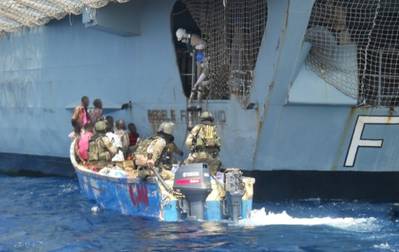Financial Aspects of Piracy Explained
Release of 'MV Leopard' crew hostages by Somali pirates, prompts Denmark researchers 'RiskIntelligence' to give general ransom & pirate 'investment' insights.
Economic terminology such as “market” is used in the below to describe the criminal activities of hijacking and ransom.
During February 2011 a total of 37 ships were held along the shoreline of Somalia, compared to only two in 2008. The average time of holding at the time the ship is relased rose from only three months in 2008 to 13 months on average in 2012. At the end of March 2013, the average time held in captivity was 28 months for the remaining western crews in Somalia.
Ransoms
The ransom demand is a result of an estimate of the value of the ship, the crew and sometimes the cargo (especially if oil), nationality and based on going “market rates”. The demand will often be 3- 5 times higher than anticipated agreed ransom to offer room for negotiation. The ransoms paid are well known in Somalia and as such the pirate leaders/investors have a good indication of the levels. Sometimes there have been side-payments made that are not known in the pirate community. The ransoms demanded for hostages without ships have been based on largely the same basics and have in cases involving Western hostages not differed much from those with ships in relative terms. The agreed ransoms have increased over time due to “market developments”.
Investors/leaders
Most hijackings off Somalia has been carried out by a pirate attack team that has been set up and deployed by a consortium of pirate leaders and investors. A pirate consortium has often been set up for the single operation. The number of investors normally has been in the range of 3-6 and has often been changing during the course of a hijacking. This is mostly due to other parties getting a share of the ransom against delivering services (food, quat, money, security etc). Sometimes investors have also left consortia due to disagreements.
Somali pirate investors have originally been a very small group of people around the original leaders – Afweyne, Garad and Boyah, but from 2008 the number exploded as junior leaders got shares of ransoms and reinvested in new pirate operations as well as other people started to invest in pirate networks. At the height of Somali piracy in 2010-2011 more than 250 investors were active.
Pre-2010 the investors had a highly lucrative business which gave a high probability of success – the investor could identify it as: “you know what you get”, it was about catching a vessel, negotiate release, share the ransom and most likely deploy pirate attack teams again.
Around 2010 the investors started to feel the results of the military deployments and the probability of success started to decline – the investor could identify his scenario as “you don’t know what you get”, catch a vessel, hold and negotiate, maximise ransom/output for the duration as the investors were not any more sure about getting a vessel again. This lead to increasing holding times as the investors/leaders knew what they had, but did not know if and what they might get in the future. During late 2011 and 2012 the deployment of armed guards even more decreased the probability of success.
The report may be accessed here.











